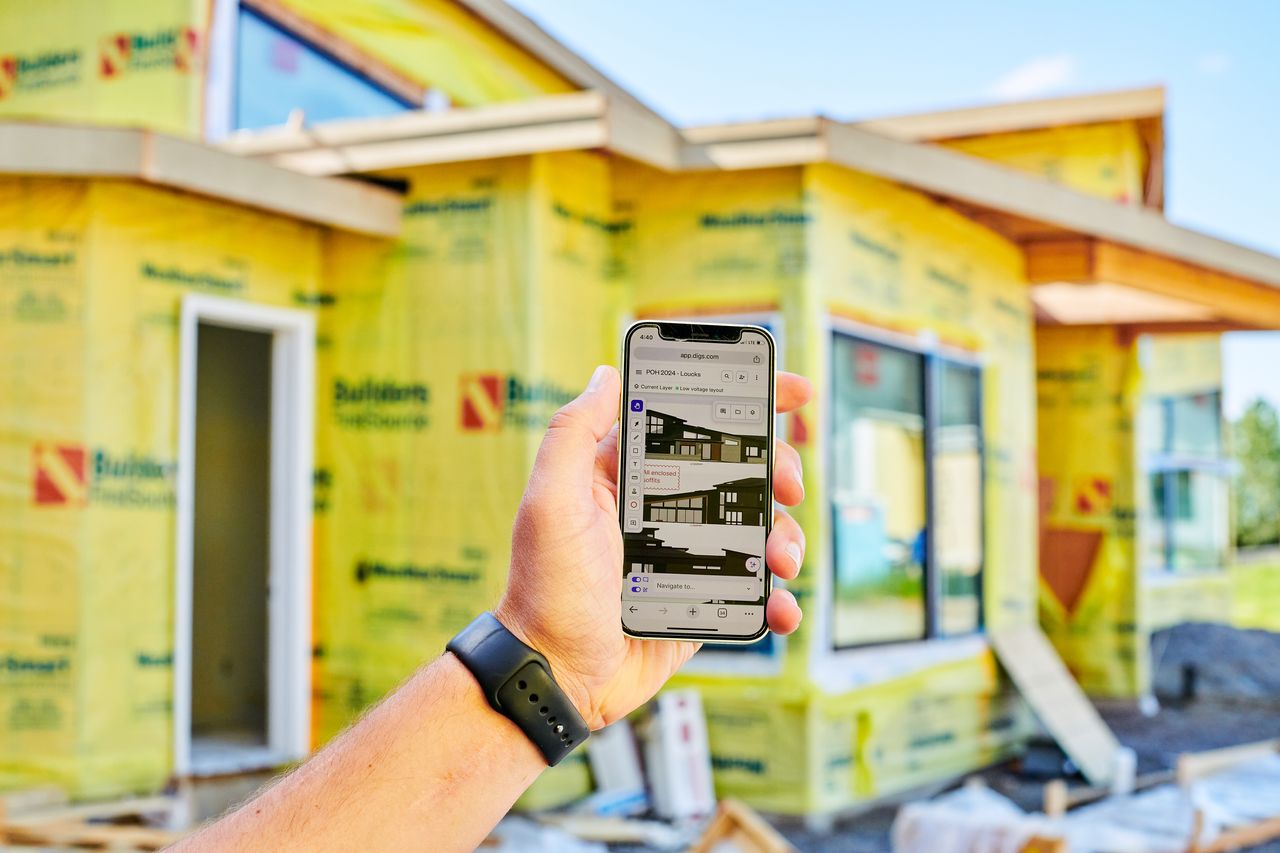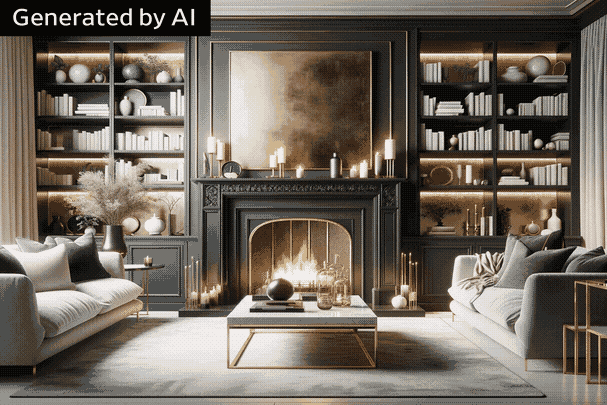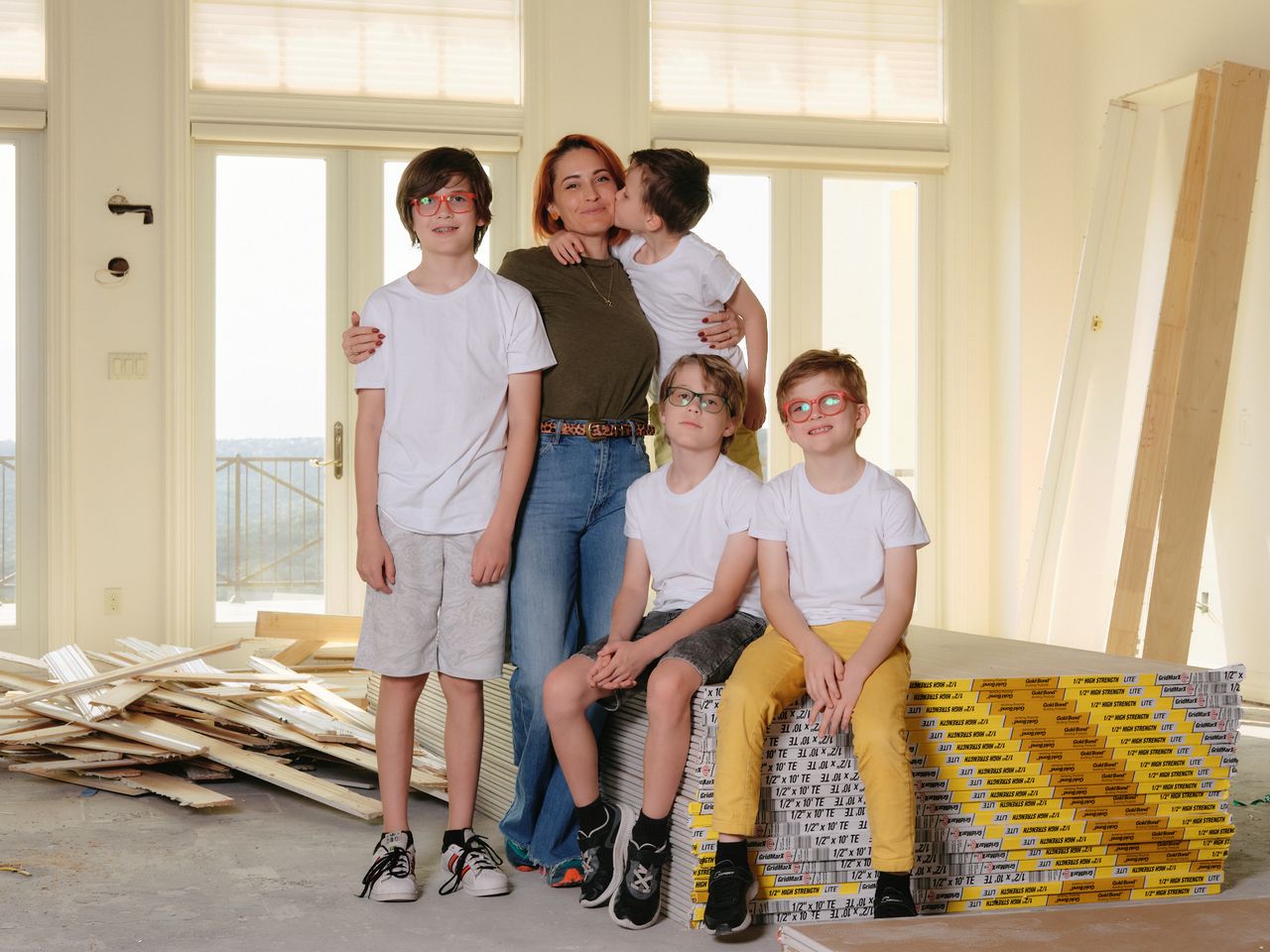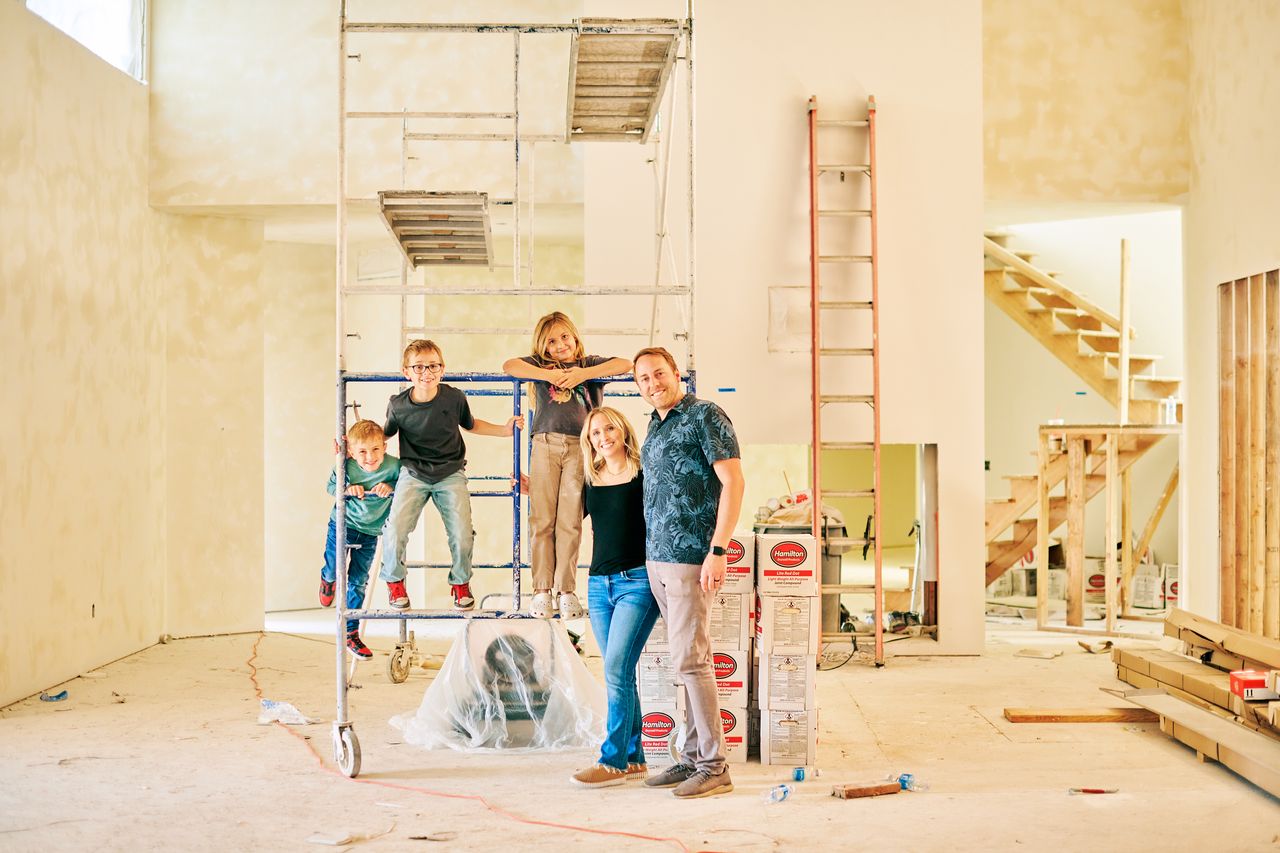Stressing Over Your Next Home Renovation Project? Let AI Handle It.
A sea of apps is helping take the headache out of home design and construction. ‘There seems to be a new one every day.’
Halfway through the building process of Kyle Loucks’s new five-bedroom, 5,800-square-foot house in Vancouver, Wash., his wife decided she wanted to add a sports court.
At first he panicked. “One seemingly small decision, like ‘let’s put a hoop here,’ has a ripple effect,” says Loucks, 37, a former Meta engineer who founded a joint-rolling technology company called RollPros.
Using new AI software called Digs on his laptop, he put a box into the house plans, first in the backyard. Then, seeing that it wouldn’t fit well, he moved it to the driveway. Within minutes, his contractor, notified by Digs of the change, confirmed that the dimensions would work and messaged the concrete guys to let them know before they did the pour and to see if they had any input on holes for a pickleball net. The landscape designer weighed in, suggesting a couple of trees nearby to help it blend in, and the lighting subcontractor advised them on how a flood light would affect the high-voltage plan.

“It helped bypass the possibility of human error and miscommunication,” says Loucks, whose home is slated to cost around $2.2 million and to be finished in October.
Homeowners are experimenting with an explosion of new artificial intelligence applications to quickly visualise an array of layout and style ideas, coordinate with builders and designers and estimate costs. These new tools say they can help save time and money in the building and renovation process, which has traditionally been filled with seemingly endless decisions and an avalanche of paperwork that often result in longer projects and ballooning costs.
There are now dozens of AI apps related to home construction, design and renovation—most of which have sprung up in the past two years.
“There seems to be a new one every day,” says Patrick O’Toole , publisher of Qualified Remodeler, which did a survey in March 2023 of its 83,000 readers and found that about half have tried generative AI tools.
Some apps, like Renovate AI, focus on visualisation. Users can generate images to see how different design ideas might look by uploading photos or drawings of their rooms. Then they can choose styles like “rustic farmhouse” or tell the tool to adjust specific elements like paint colors, lighting, furniture or the style of the cabinets.
Other platforms, like Digs, use AI to create 3-D “dollhouse” floor plans and manage the logistics of a project, room by room. Digs can layer in the location of specs like the load-bearing beams, plumbing lines and lighting plans to show where walls can be knocked down, and users can query it to get the make and model of an appliance or the dimensions of the wall, all sourced from the original documents.
Analysts say the demand for new tools is driven in part by the state of the housing market. The decline in construction of new houses, combined with a rapid run-up in interest rates over the past two years that sent mortgage rates soaring, has resulted in many people choosing to stay and fix or add on to homes they already own. Spending on DIY projects soared 44% from 2019 to 2021, the latest stats available, according to Harvard’s Joint Center for Housing Studies.
The new apps offer homeowners a way of gaining control over what can be a dizzyingly complicated and opaque process, though not without their own risks.

Jess Sandlin, 38, is working with an architect and designer to renovate a 9,000-square-foot home she and her boyfriend bought in Austin, Texas, for $2.5 million. But she is also using an app called Remodel AI as well as ChatGPT to help her get a sense of the possibilities and to empower her with images she can show since her vocabulary doesn’t include technical architectural terms.
“I wanted to get a sense of my own style and be a little more knowledgeable so I didn’t just get their style,” says Sandlin, executive director of Word Playground, a nonprofit for teaching children literacy.
As she tested out different prompts to home in on her own design sensibilities, Remodel AI generated hundreds of options—including some with furniture on the ceiling and the walls. She wanted an indoor play area for her four sons, aged 5 through 13, to include multiple layers of hammocks, a zip line and netting. The app couldn’t handle it. “It had no idea what I was talking about. It could not compute,” she says.
Dirk Morris, founder and CEO Reimage AI, the maker of the Remodel AI app, which costs $10 a month or $50 a year, says Sandlin may have been using the wrong tool: Sometimes people try to use the standard interior remodel tool to make extensive structural changes, he says.
Even when Sandlin was able to generate exactly what she wanted, she ran into human roadblocks. When she showed her architect AI-generated photos of a bronze fireplace with a brass mantle, “they rolled their eyes at me,” she says. Eventually, her designer agreed to the bronze.
While traditionally AI tools were aimed at professionals, the newer apps are letting laypeople in on the game, says Michael Anschel , a principal at Minneapolis-based OA Design and Build Architecture.

However, he says the tools aren’t sharp enough yet. For example, when Anschel asked Renovate AI to generate a kitchen with hand-scraped stone counters and paisley wallpaper, he got an image with stainless steel counters and paisley wallpaper on the cabinets and the ceiling.
Other pros have expressed concern about having to address design ideas that might not be possible from clients armed with AI-generated images. “It could be extremely annoying,” says Daniel Kaven of Portland, Ore.-based William Kaven Architecture.
Laura Bindloss, 38, who owns a social media and public relations agency, has renovated several homes, but she had never used AI to help until her most recent project: a 2,000-square-foot house she bought in March for $575,000 in Bellport, N.Y. Bindloss, who plans to live in the house on weekends as well as rent it out, was looking to spend a total of around $200,000, with $55,000 on the kitchen alone. She wanted to get the project done quickly so she could start renting it out this summer.
“I’d heard about it as a visualisation tool but it didn’t seem that useful,” she says. When she hired cabinetmaker Isla Porter to design the kitchen, she found that the company was using AI provider Skipp, which can make a scan from a phone into detailed renovation plans, complete with renderings, materials lists and construction-ready documents. The first step was to take a 3-D scan of the space with her iPad. She then answered a 40-question survey, with questions like “where do most meals happen” and “what do you like most and least about your current kitchen.”
The AI used her scan and survey responses to generate hundreds of floor plan options within minutes. Isla Porter’s designers then manually edited them, significantly reducing the time it would have taken if the designers had to go through the survey results without the technology, says Sharon Dranko, Isla Porter’s founder. Bindloss then picked from the three options Isla Porter recommended, choosing materials and finishes in the program to see how everything would look. The design plans for the kitchen were finalized in two weeks, says Bindloss.
Dranko says that even though the AI’s measurements tend to be 98% accurate, it’s still crucial to have a human designer double check everything. AI is also off sometimes when it comes to understanding living patterns, meaning how the way a person uses their kitchen should impact the design, she says. Dranko says she is constantly feeding it new information like colors and fabrics to make it more useful when it comes to finding the right style and look for her clients.
The idea of using AI in his home renovations came to Kade Boverhof when he was looking at possible floor plans for the renovation of a 1,900-square-foot house he bought in Grand Rapids, Mich., for $150,000.
Boverhof, 31, wanted to create a floor plan for the house that took into account all the iterations he’d devised in previous renovation projects using a computer-aided design (CAD) software program. There must be an AI program that could do this, he thought.
After searching Google and going on Reddit to ask others what they were using, Boverhof came across an app in development called A-Space, which let him use its tools for free as an early adopter in exchange for his feedback. He downloaded his existing blueprints, which included information on the location of walls that were necessary to hold up the structure, added some instructions and hit generate. From the four options, Boverhof locked in the kitchen location he liked best and again pushed the generate button to see the options for the other rooms around that decision.
Boverhof says the results weren’t perfect. It didn’t know the local building codes for the city of Grand Rapids, such as the percentage of space required to be windows or doors. But he says he saved many hours and got back new layout ideas that he could tailor.
“It’s at a primitive stage, but the possibilities are there,” he says.
Ryan Fink, CEO and co-founder of Digs, says that of the some 6,000 homes currently on its platform, half have homeowners participating. Builders currently pay $69 per user per month, but the contractors, vendors and homeowners involved in the projects participate for free, he says.
Sid Sarasvati founded Renovate AI because of the difficulties he encountered with staging homes for sale. He says the app will continue to improve, such as offering users the option to click on products to buy online, create budgets and connect with vendors. Launched in January 2023, it has some 15,000 subscribers now, 40% of whom are on a $10-a-week plan and 60% of whom are on a $40 annual plan.
Many of the AI apps are aimed at improving the speed and communication for homeowners working with an architect or designer. But some, including A-Space, hope to democratise the process and reduce the need for architects by automating tasks like filling in planning applications.
“We want to give every person access to architectural expertise,” says Ziyad Mourad, CEO and co-founder of A-Space, which plans on offering the app free to homeowners for a single project and for $50 a month to architects for unlimited use.
WSJ Tests an AI Remodelling Tool
Rashad Fakhouri, an architect at London-based Pilbrow & Partners, who is currently using A-Space on the side but not for work projects, says he doesn’t foresee a time when AI will replace architects because of the need for the architect’s aesthetics and their ability to troubleshoot throughout the process.
“We will still be necessary,” he says.
In five years, AI tools for home remodelling and construction will become more integrated, says Jose Luis Blanco, senior partner at McKinsey who leads the firm’s engineering and construction work in North America. “We are in the early innings,” he says.
Mike Rowe, of “Dirty Jobs” TV fame and a spokesman for AI provider Digs, agrees that the continued expansion of AI will democratise the home-building process. “It will put a lot more power in the consumers’ hands,” he says.
Some homeowners say the tools are already offering a newfound leg up in managing their projects with the pros.
“AI doesn’t talk back,” says Austin homeowner Sandlin.
 Copyright 2020, Dow Jones & Company, Inc. All Rights Reserved Worldwide. LEARN MORE
Copyright 2020, Dow Jones & Company, Inc. All Rights Reserved Worldwide. LEARN MORE
This stylish family home combines a classic palette and finishes with a flexible floorplan
Just 55 minutes from Sydney, make this your creative getaway located in the majestic Hawkesbury region.
The remote northern island wants more visitors: ‘It’s the rumbling before the herd is coming,’ one hotel manager says
As European hot spots become overcrowded , travellers are digging deeper to find those less-populated but still brag-worthy locations. Greenland, moving up the list, is bracing for its new popularity.
Aria Varasteh has been to 69 countries, including almost all of Europe. He now wants to visit more remote places and avoid spots swarmed by tourists—starting with Greenland.
“I want a taste of something different,” said the 34-year-old founder of a consulting firm serving clients in the Washington, D.C., area.
He originally planned to go to Nuuk, the island’s capital, this fall via out-of-the-way connections, given there wasn’t a nonstop flight from the U.S. But this month United Airlines announced a nonstop, four-hour flight from Newark Liberty International Airport in New Jersey to Nuuk. The route, beginning next summer, is a first for a U.S. airline, according to Greenland tourism officials.
It marks a significant milestone in the territory’s push for more international visitors. Airlines ran flights with a combined 55,000 seats to Greenland from April to August of this year, says Jens Lauridsen, chief executive officer of Greenland Airports. That figure will nearly double next year in the same period, he says, to about 105,000 seats.
The possible coming surge of travellers also presents a challenge for a vast island of 56,000 people as nearby destinations from Iceland to Spain grapple with the consequences of over tourism.
Greenlandic officials say they have watched closely and made deliberate efforts to slowly scale up their plans for visitors. An investment north of $700 million will yield three new airports, the first of which will open next month in Nuuk.
“It’s the rumbling before the herd is coming,” says Mads Mitchell, general manager of Hotel Nordbo, a 67-room property in Nuuk. The owner of his property is considering adding 50 more rooms to meet demand in the coming years.
Mitchell has recently met with travel agents from Brooklyn, N.Y., South Korea and China. He says he welcomes new tourists, but fears tourism will grow too quickly.
“Like in Barcelona, you get tired of tourists, because it’s too much and it pushes out the locals, that is my concern,” he says. “So it’s finding this balance of like showing the love for Greenland and showing the amazing possibilities, but not getting too much too fast.”
Greenland’s buildup
Greenland is an autonomous territory of Denmark more than three times the size of Texas. Tourists travel by boat or small aircraft when venturing to different regions—virtually no roads connect towns or settlements.
Greenland decided to invest in airport infrastructure in 2018 as part of an effort to expand tourism and its role in the economy, which is largely dependent on fishing and subsidies from Denmark. In the coming years, airports in Ilulissat and Qaqortoq, areas known for their scenic fjords, will open.
One narrow-body flight, like what United plans, will generate $200,000 in spending, including hotels, tours and other purchases, Lauridsen says. He calls it a “very significant economic impact.”
In 2023, foreign tourism brought a total of over $270 million to Greenland’s economy, according to Visit Greenland, the tourism and marketing arm owned by the government. Expedition cruises visit the territory, as well as adventure tours.
United will fly twice weekly to Nuuk on its 737 MAX 8, which will seat 166 passengers, starting in June .
“We look for new destinations, we look for hot destinations and destinations, most importantly, we can make money in,” Andrew Nocella , United’s chief commercial officer, said in the company’s earnings call earlier in October.
On the runway
Greenland has looked to nearby Iceland to learn from its experiences with tourism, says Air Greenland Group CEO Jacob Nitter Sørensen. Tiny Iceland still has about seven times the population of its western neighbour.
Nuuk’s new airport will become the new trans-Atlantic hub for Air Greenland, the national carrier. It flies to 14 airports and 46 heliports across the territory.
“Of course, there are discussions about avoiding mass tourism. But right now, I think there is a natural limit in terms of the receiving capacity,” Nitter says.
Air Greenland doesn’t fly nonstop from the U.S. because there isn’t currently enough space to accommodate all travellers in hotels, Nitter says. Air Greenland is building a new hotel in Ilulissat to increase capacity when the airport opens.
Nuuk has just over 550 hotel rooms, according to government documents. A tourism analysis published by Visit Greenland predicts there could be a shortage in rooms beginning in 2027. Most U.S. visitors will stay four to 10 nights, according to traveler sentiment data from Visit Greenland.
As travel picks up, visitors should expect more changes. Officials expect to pass new legislation that would further regulate tourism in time for the 2025 season. Rules on zoning would give local communities the power to limit tourism when needed, says Naaja H. Nathanielsen, minister for business, trade, raw materials, justice and gender equality.
Areas in a so-called red zone would ban tour operators. In northern Greenland, traditional hunting takes place at certain times of year and requires silence, which doesn’t work with cruise ships coming in, Nathanielsen says.
Part of the proposal would require tour operators to be locally based to ensure they pay taxes in Greenland and so that tourists receive local knowledge of the culture. Nathanielsen also plans to introduce a proposal to govern cruise tourism to ensure more travelers stay and eat locally, rather than just walk around for a few hours and grab a cup of coffee, she says.
Public sentiment has remained in favour of tourism as visitor arrivals have increased, Nathanielsen says.
—Roshan Fernandez contributed to this article.
This stylish family home combines a classic palette and finishes with a flexible floorplan
Just 55 minutes from Sydney, make this your creative getaway located in the majestic Hawkesbury region.






















